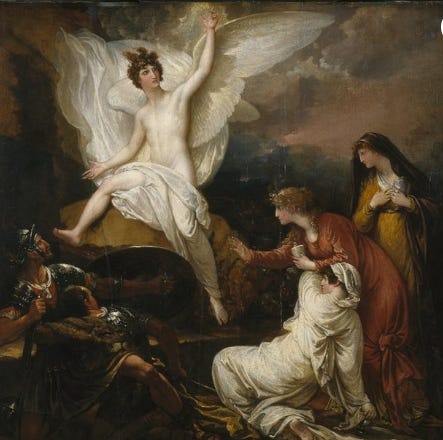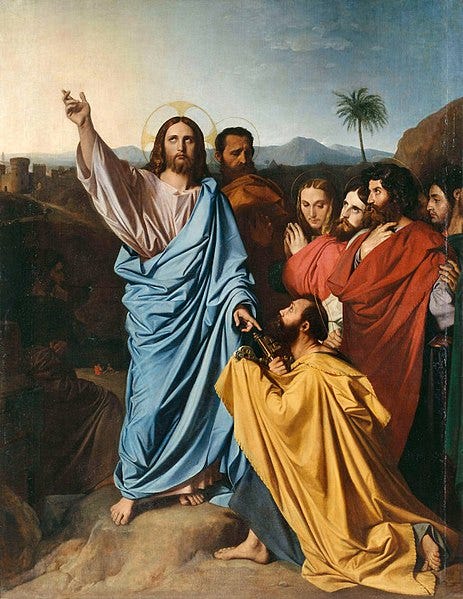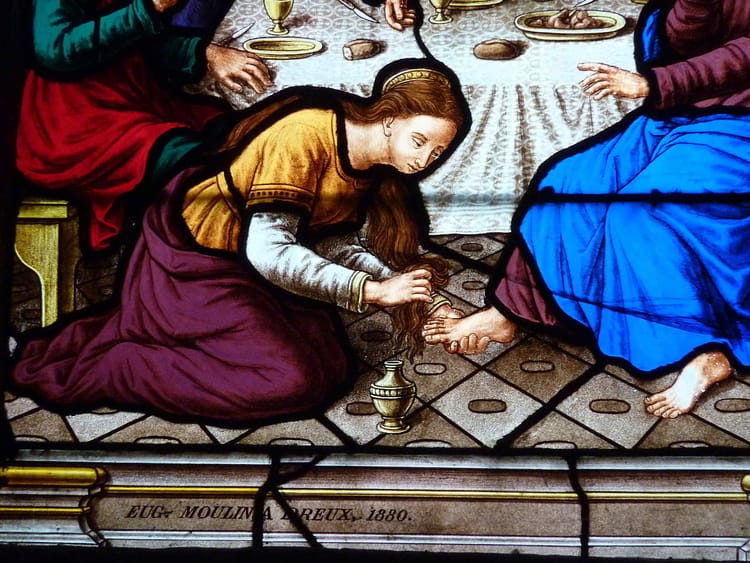It's Easter Sunday

Read "It's Holy Monday"
Read "It's Holy Tuesday"
Read "It's Spy Wednesday"
Read "It's Maundy Thursday"
Read "It's Good Friday"
Read "It's Black Saturday"
“On the third day, the friends of Christ coming at daybreak to the place found the grave empty, and the stone rolled away. In varying ways, they realized the new wonder; but even they hardly realized that the world had died in the night. What they were looking at was the first day of a new creation, with a new heaven and a new earth; and the semblance of the garden God walking again in the garden, in the cool not of the evening but the dawn.”
— G.K. Chesterton, Everlasting Man —
When the Sabbath was over, Mary Magdalene, Mary the mother of James, and Salome bought spices so that they might go to anoint Jesus’ body. Very early on the first day of the week, just after sunrise, they were on their way to the tomb and they asked each other, “Who will roll the stone away from the entrance of the tomb?”
But when they looked up, they saw that the stone, which was very large, had been rolled away. As they entered the tomb, they saw a young man dressed in a white robe sitting on the right side, and they were alarmed.
“Don’t be alarmed,” he said. “You are looking for Jesus the Nazarene, who was crucified. He has risen! He is not here. See the place where they laid him. But go, tell his disciples and Peter, “He is going ahead of you into Galilee. There you will see him, just as he told you.”
– Mark 16:1-7 (NIV)
The tomb is empty.
Jesus was not there.
This wasn’t supposed to happen.
Dead people stay in their tombs.
But this tomb is empty.
Sabbath prohibitions had allowed time only to wrap the body Friday afternoon before the Sabbath, so the women needed to get to the tomb as early as possible to complete the washing and anointing of the body. So, after a long, likely sleepless Friday night and Sabbath, the women rose early to go to the tomb, hoping that the stench of rapid decomposition in the hot Mediterranean days might have been mitigated adequately by the two-thousand-foot elevation of Jerusalem in April combined with a sealed tomb. With spices in hand, possibly purchased the previous evening after the Sabbath had ended, they approach the tomb, wondering who might be around to help them roll the stone away.
As they approach the tomb, they see that the stone has been rolled away. Has someone else come to anoint the body? Has Joseph returned to his tomb to ensure all is well, given that everything happened so quickly Friday evening? The women went to the tomb prepared to deal with a dead body. I think we can be sure that an empty tomb was not even on their radar.

Entering the tomb, a young man dressed in white frightens them. The tomb was not empty, but the one they expected to see was not there.
“Don’t be afraid,” the young man tells them,…
Translation: Don’t freak out! Take a deep breath. Everything is going to be okay.
“You are looking for Jesus the Nazarene…
Translation: Yes, they were in the right tomb.
… who was crucified…
Translation: Yes, he really was dead.
…He has risen…
Translation: Here’s the breaking news—HE IS NO LONGER DEAD! Yes, that is correct.
…He is not here…
Translation: As you can plainly see.
… See the place where they laid him…
Translation: Yes, he’s definitely not there.
…But go, tell his disciples and Peter that Jesus is going ahead of you into Galilee…
Translation: That’s right, there will be no burial preparations here today. Instead, you will be the first to proclaim this news about Jesus. Get movin’!
…There you will see him…
Translation: He is not here. Go to where he is. When you get there, you will see him. And when you do, your life will never be the same again.
The Bible does not offer a neatly folded map or “a perfect plan for your life” or a bottle-fed blueprint for living. The good news was not a new set of laws or a new set of ethical injunctions or a new and better seven-point PLAN.
The good news was the story of a victory that had already been won by the person of Jesus the Christ. The good news is glad tidings of a beautiful new relationship between humans and the divine: God so loved the world… Christ so redeemed the world…The Holy Spirit so pervades the world…That a new world is coming. That’s the GOOD NEWS!
— Leonard Sweet, “So Beautiful” (Kindle 2243) —
Peter would become a key figure as the story moves forward from here. By way of the young man’s message to the women, Peter and the other failed disciples are welcomed back into a shalom-based relationship with Jesus. They are invited to rejoin him in his mission.
Judas is left out for obvious reasons, but I can’t help but wonder what a reunion of Judas and Jesus might have looked like had Judas not ended his life. Can you imagine what that scene would have looked like?
I think it would have been epic.
“Do not abandon yourselves to despair. We are the Easter people and hallelujah is our song.”
― Pope John Paul II —
Trembling and bewildered, the women went out and fled from the tomb. They said nothing to anyone, because they were afraid. (Mark 16:8, NIV)
Dazed and confused, the women leave the tomb. What had just happened? Could this be true? Who was that young man in white? Was that an angel? Jesus was dead. We saw it. He was wrapped up and put into the tomb. We saw it. Did somebody come and steal the corpse? Is this a cruel joke? What is going on?
It is not hard to imagine the women hastily leaving the tomb only to stop some distance away to catch their breath. Would they tell the disciples to look for Jesus somewhere in Galilee? What would Peter think? Would he go to Galilee as instructed? Or would they conclude that the women must be overcome with grief to the point of experiencing an exhaustion-induced hallucination? It is not difficult to imagine these women, confused and fearful, finding it difficult to say anything to anyone.
Ancient writers loved to use irony. How often do the gospel writers portray Jesus telling a newly healed man or woman not to tell anyone what had just happened, only to have them turn around and do just that? Here, the tables are turned—the women are told to “go and tell,” but Mark ends his Jesus story abruptly with the irony of the women “not telling anyone because they were afraid.”
Many scholars conclude that the meaning here, which would have been understood by the original readers and hearers of Mark’s gospel, is that the women did not tell anyone other than Peter and the disciples (those to whom they were given the direct command to speak).
Matthew tells us that following the encounter with the angel, the “women hurried away from the tomb, afraid yet filled with joy, and ran to tell the disciples” (Mt 28:8). Luke writes that “When [the women] came back from the tomb, they told all these things to the Eleven and all the others” (Lk 24:9).
Ancient writers rarely wrote purely to record historical facts, especially when writing a theological narrative like what is found in the gospels. For Matthew, Mark, Luke, and John, the primary purpose of writing these gospel accounts is not merely the who, what, when, and where of Jesus’ life and ministry. These are important, but not more than the how and the why and, most importantly, the impact of the writings in the heart of the reader and hearer.
Mark doesn’t explain the reasons for ending his gospel account with the abrupt irony of the women being made speechless from fear. What I see here, though, is Mark leaving the story's ending open. Yes, the women were afraid. Yes, it would be entirely natural for them to be paralyzed for some time by fear and uncertainty. Yet, looking back on this story, we can see that the women did, eventually, relay the message.
They did go.
They did tell.

More importantly, Mark’s story ends with unfinished abruptness because I am the one needing to respond. Mark’s purpose is not simply to put truth into writing. He is putting the truth of the story of Jesus Christ into writing so that I, and all who read and all who hear, might experience transformation of heart and mind, an opportunity made possible only by the grace of God working in our world.
So, how will I respond?
Simon from Cyrene carried the cross of Christ.
Will I, too, carry his cross?
Jesus humbled himself to the point of death.
Will I humble myself and follow, too, no matter where the path may lead?
Jesus lived and died in the midst of those who desperately needed God.
Where do I live my life?
For whom, or what, am I willing to die?
Jesus never tried to save himself.
How often am I focused only on myself?
Jesus proclaimed his trust in the Father, even at the point of death.
Do I have that kind of trust?
People’s lives were changed by seeing the way Jesus lived.
What do people see in the way I live?
The centurion was moved deeply by observing how Jesus died.
Will my life, even at the point of greatest trial, point to Christ?
If the message of Mark’s gospel is for me, then I must be the one to respond.
Will I be silenced by fear, telling no one?
Or will I take this message to others, telling them the story of the risen Christ and inviting them into the mission to which God is calling us?
“If I take Easter as the starting point, the one incontrovertible fact about how God treats those whom he loves, then human history becomes the contradiction and Easter a preview of ultimate reality.”
― Philip Yancey ―
The seventeenth chapter of Mark is not the story of what the women did next. It is my story. It is your story. It is the story of every human being who has ever…
…followed Jesus closely as a disciple;
…followed Jesus from afar, not wanting to get too close;
…turned their back on God to follow the serpent;
…felt the shame that comes with the rooster’s crow;
…betrayed Jesus with a kiss for personal gain;
…heard the call to “go and tell” and walked away trembling in fear;
…struggled with doubt and uncertainty, needing to see the nail-scarred hands first.
This side of Easter, our mission is defined, not only by Jesus’ earthly ministry, but by the whole story of Jesus—his life, teaching, proclamation, death and resurrection. Our challenge, then, is to allow the character of Jesus’ mission to shape our own within our different and diverse circumstances.
— Dean Flemming, “Mission” (Kindle 1328) —
The unfinished story of Mark’s gospel is our story. The Easter story is not merely a story of what has happened but also about what is happening and what will happen. It is not only a story about what God did in the past but also what God is doing now and in the future. The celebration of Easter is not only a reminder to remember; it is a call to consecration and an appeal to action.
As God’s people, holy and dearly loved, we are the bearers of God’s image in our world. This image is most clearly seen in Jesus Christ.
We are, in fact, the body and presence of Christ in our world. We are the carriers of shalom in our world, reconciling as we have been reconciled, loving as we have been loved, and extending grace even as grace has been extended to us.
We, the Church, live according to a different purpose and plan. Our priorities are based on the paradigm of the kingdom of God, as revealed in Christ through his birth, life, death, and resurrection.
He is risen!
He walks with us in this world...
...bringing the kingdom of God down to earth.
All glory, honor, and praise are the Lord’s!
Forever and ever, amen.
“Jesus's resurrection is the beginning of God's new project not to snatch people away from earth to heaven but to colonize earth with the life of heaven. That, after all, is what the Lord's Prayer is about.”
― N.T. Wright, Surprised by Hope —
“And now brothers, I will ask you a terrible question, and God knows I ask it also of myself. Is the truth beyond all truths, beyond the stars, just this: that to live without him is the real death, that to die with him the only life?”
― Frederick Buechner, The Magnificent Defeat —
Would you do me a favor?
If you are reading this online, please scroll down to the bottom of this email and leave a comment under "Member Discussions."
NOTE: If this is your first time to leave a comment, you may need to sign in first. Just enter your email and then check your email for a personalized link. You should only have to do this once (unless you log back out when you're done).





Member discussion